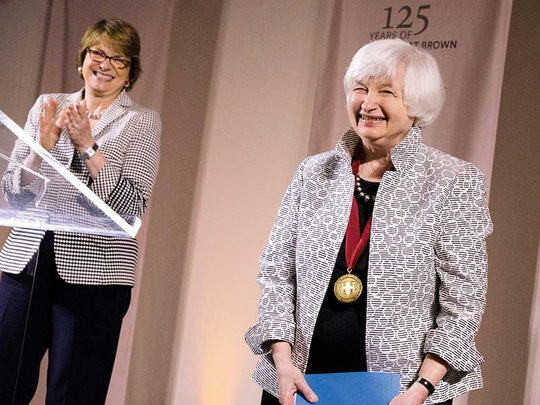
In an unusually personal speech, Janet L. Yellen, the Federal Reserve chairwoman, said Friday that policies making it easier for women to work could significantly improve the nation’s economic growth.
The sweeping movement of women from the home to the workplace during the mid-20th century, she said, was a “major factor in America’s prosperity.” But that progress has stalled in recent decades, leaving women less likely than men to hold paying jobs. Bringing more women into the workforce with policies like expanding the availability of paid leave, affordable childcare and flexible work schedules, she said, could help to lift the US economy from a long stretch of slow growth.
“Evidence suggests that many women remain unable to achieve their goals,” Yellen said in a speech at Brown University. “If these obstacles persist, we will squander the potential of many of our citizens and incur a substantial loss to the productive capacity of our economy at a time when the ageing of the population and weak productivity growth are already weighing on economic growth.”
Yellen cited one recent estimate that raising women’s participation to the same level as men’s could increase the nation’s annual economic output by 5 per cent.
Women’s participation in the workforce increased gradually through most of the 20th century, then rose more rapidly from the early 1970s through the early 1990s. About one-third of working-age women held jobs outside the home in the years after the Second World War. By the early 1990s, about three-quarters of those women worked.
Since then, however, the trend has stagnated. The proportion of women ages 25 to 54 either working or looking for work stood at 75 per cent in April.
That remains more than 10 percentage points lower than the figure for men in the same age range working or seeking work, which was 88.6 per cent in April.
Yellen’s speech was unusually narrative and unusually personal. Speaking at her alma mater, she told the stories of other women who graduated from Brown, including her husband’s aunt, Elizabeth Stafford Hirschfelder. She said Hirschfelder, who graduated in 1923, faced discrimination throughout her career as a mathematician. “I believe that Betty Stafford Hirschfelder was denied opportunities and greater success simply because she was a woman,” she said.
Yellen, who is 70, said women of her own generation had faced fewer obstacles and had more opportunities. “I enrolled at Brown fully planning to attend graduate school and have a career, as did many of my classmates in the Class of 1967,” she said. She noted that changes in policy supported and reinforced changes in society. A 1974 law, for example, allowed women to apply for loans without a male co-signer.
Women gained entry into a wider range of professions, and the gap between men’s and women’s wages narrowed significantly. Nancy H. Teeters became the first woman appointed to the Fed’s board in September 1978. Yellen said that their increased workforce participation had produced clear benefits not only for women, but also for men, for the children of working women and for the US economy.
“The evidence shows that the rise in women’s participation has contributed to widespread improvements in the safety and productivity of our workplaces, to the health of families and to the macroeconomic success that our country has enjoyed,” she said. She spoke at a conference titled “125 Years of Women at Brown.”
That progress, however, has stalled in the United States even as the participation of women in the workforce has continued to rise in other developed countries. The United States, which had one of the highest rates of participation in the early 1990s, fell to 17th among 22 developed nations in one recent analysis.
That analysis, a 2013 study by Francine D. Blau and Lawrence M. Kahn, both of Cornell University, attributed much of the difference to government policies. The United States lags behind other countries in the availability of paid maternity leave, affordable child care and flexible work schedules. Blau and Kahn estimated that adopting European policies on those issues could close more than half of the gap in the United States between male and female labour force participation.
Yellen also cited research showing that women still make about 10 per cent less, on average, than men with similar backgrounds who work in similar positions.







